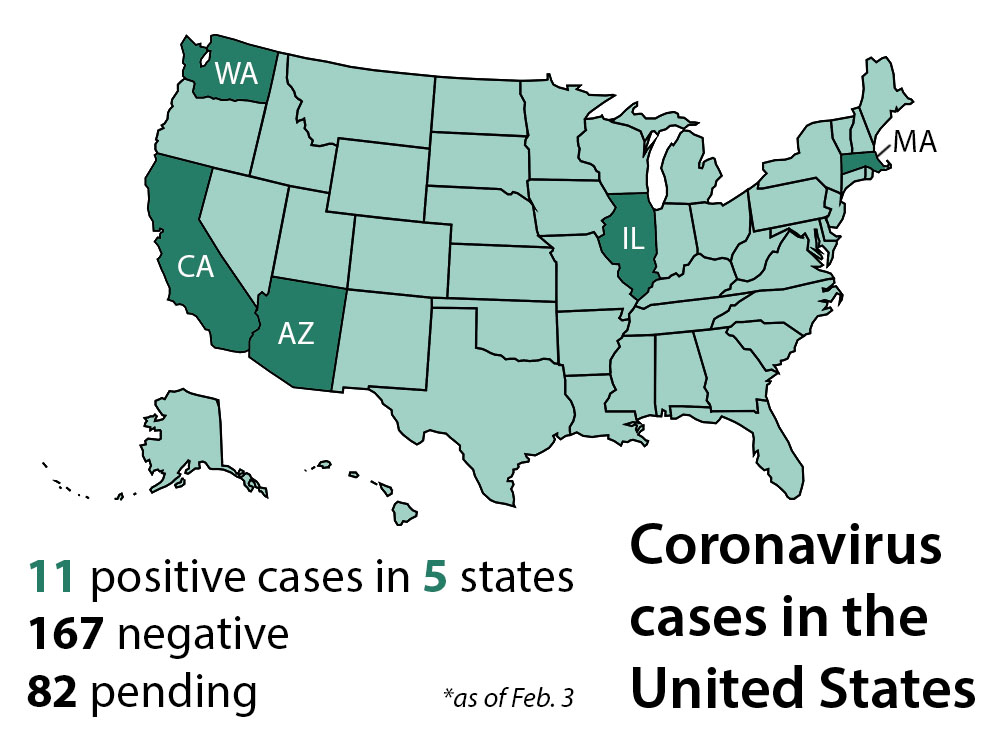
The new wave of coronavirus, 11 positive cases in the U.S.
Over 20,000 people worldwide have been positively diagnosed with the 2019 novel coronavirus, according to the Centers for Disease Control and Prevention (CDC). Only 11 cases have positive results in the United States, but the number continues to grow.
With the first case of novel coronavirus occurring in Wuhan, China in December 2019, there is still not a total understanding of this version of the coronavirus.
Victor Huber, an associate professor of basic biomedical sciences, specializes in the influenza viruses. He said he’s not an expert in the coronavirus, but not many people are yet.
“It’s something that is brand new, so nobody’s an expert on this,” Huber said. “I’ve done a lot of looking at things and trying to identify what the current status is because it’s a constantly developing story.”
Initially, Huber said, medical specialists thought novel coronaviruses spread from animal to human — they quickly discovered it also spreads from human to human. Usually, the spread between humans is due to close contact, Huber said.
Although the novel coronavirus only emerged at the end of 2019, Heather Kleeman, a doctor at Sanford Vermillion Clinic, said there are other forms of this virus that spread internationally in years prior.
“Coronavirus is just that, a virus from the family of viruses that get their name from their shape of a crown-corona. There are two types you may have heard before in the news — SARS-CoV, severe acute respiratory syndrome coronavirus and MERS-Cov Middle East Respiratory Syndrome coronavirus,” she said in an email interview with The Volante. “This new strain … was identified as the cause of a cluster of pneumonia cases in Wuhan, China at the end of 2019.”
These pandemic viruses can spread from continent to continent, Huber said, by people traveling, which is only more prevalent now, due to air flights.
“A lot of advice from the CDC is coming out saying ‘if you’ve been to China, and now you’re starting to feel sick, let your healthcare provider know,’” Huber said.
The best way to avoid getting sick, Kleeman said, is to avoid traveling to infected areas, like China and take the necessary precautionary steps when feeling ill.
“Although many of the reported infections are not severe, approximately 20% of confirmed patients have had a critical illness,” Kleeman said. “Most of the fatal cases have occurred in patients with underlying medical comorbidities.”
While the current positive U.S. cases are only in Washington state, Illinois, California, Arizona and Massachusetts, 36 states have had possible cases already. As more people are getting tested, Huber said it’s important to take any illness seriously.
“I would say the danger right now is that we don’t know much. With influenza, it’s something we know about,” Huber said. “The lack of knowledge brings a little bit of fear because we don’t know how to proceed because we don’t know what this virus is going to do.”
If the coronavirus was to spread to Vermillion, Kleeman said healthy people will be able to fight it off much like influenza viruses.
“The biggest concern right now is influenza in the U.S. It has killed about 8,200 people,” Kleeman said. “People can prevent the spread like they do with the coronavirus and stay home when they are sick or feverish. Wash hands well, cover a cough and do not share foods.”

